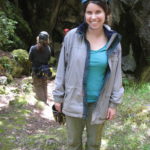Jessica Oster, Vanderbilt University – Caves Hold Clues to Climate Change
 Climate change doesn’t always happen over a long period of time.
Climate change doesn’t always happen over a long period of time.
Jessica Oster, assistant professor in the department of earth and environmental sciences at Vanderbilt University, looks underground for evidence of an abrupt change to the world’s weather.
I am an Assistant Professor in the Earth and Environmental Sciences Department at Vanderbilt University. I am interested in climate, water, and caves.
Caves Hold Clues to Climate Change
We often think of climate change as something that happens gradually over hundreds or thousands of years, but there is evidence that the climate is capable of changing in a geologic instant. One such abrupt change happened 8,200 years ago. As the Earth was warming and ice sheets were retreating, an ice dam broke, sending massive amounts of glacial melt water into the North Atlantic Ocean. Ice cores from Greenland show that this flood of fresh water triggered a cold snap that lasted for about 150 years. Climate records suggest that this event had ripple effects across the world, such as changes in monsoons in Asia and South America.
A stalagmite from a cave in the Santa Cruz Mountains in California provides some of the first evidence of how western North America was affected by this cold snap. Over thousands of years, water dripping in caves creates mineral formations such as stalagmites. As they grow, stalagmites record small variations in water chemistry that are controlled by environmental change above the cave. Stalagmites can grow steadily and sometimes rapidly, and can be dated with high precision which makes them excellent candidates for examining abrupt climate change.
Around 8,200 years ago, we found large changes in the carbon signature in the stalagmite as well as abrupt changes in the concentrations of phosphorus and magnesium. Applying our knowledge of how similar changes occur in cave water chemistry today, we suggest that these changes in the stalagmite point to a very wet and stormy interval on the California coast. In recent years California has experienced both record-breaking droughts and powerful winter storms. Our findings that climate in California, and elsewhere, can be influenced by events halfway around the world raises interesting questions in this time of rising temperatures and global change.


